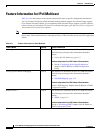
42-4
Cisco ASR 901 Series Aggregation Services Router Software Configuration Guide
OL-23826-09
Chapter 42 IPv6 Multicast
Feature Overview
A set of queriers and hosts that receive multicast data streams from the same source is called a multicast
group. Queriers and hosts use MLD reports to join and leave multicast groups and to begin receiving
group traffic.
MLD uses the Internet Control Message Protocol (ICMP) to carry its messages. All MLD messages are
link-local with a hop limit of 1, and they all have the alert option set. The alert option implies an
implementation of the hop-by-hop option header.
MLD has three types of messages:
• Query—General, group-specific, and multicast-address-specific. In a query message, the multicast
address field is set to 0 when MLD sends a general query. The general query learns which multicast
addresses have listeners on an attached link. Group-specific and multicast-address-specific queries
are the same. A group address is a multicast address.
• Report—In a report message, the multicast address field is that of the specific IPv6 multicast address
to which the sender is listening.
• Done—In a done message, the multicast address field is that of the specific IPv6 multicast address
to which the source of the MLD message is no longer listening.
An MLD report must be sent with a valid IPv6 link-local source address, or the unspecified address (::).
If the sending interface has not yet acquired a valid link-local address. Sending reports with the
unspecified address is allowed to support the use of IPv6 multicast in the Neighbor Discovery Protocol.
For stateless autoconfiguration, a node is required to join several IPv6 multicast groups in order to
perform duplicate address detection (DAD). Prior to DAD, the only address the reporting node has for
the sending interface is a tentative one, which cannot be used for communication. Therefore, the
unspecified address must be used.
MLD states that result from MLD version 2 or MLD version 1 membership reports can be limited
globally or by interface. The MLD group limits feature provides protection against denial of service
(DoS) attacks caused by MLD packets. Membership reports in excess of the configured limits are not
entered in the MLD cache, and traffic for those excess membership reports are not forwarded.
MLD provides support for source filtering. Source filtering allows a node to report interest in listening
to packets only from specific source addresses (as required to support SSM), or from all addresses except
specific source addresses sent to a particular multicast address.
When a host using MLD version 1 sends a leave message, the device needs to send query messages to
reconfirm that this host was the last MLD version 1 host joined to the group before it can stop forwarding
traffic. This function takes about 2 seconds. This “leave latency” is also present in IGMP version 2 for
IPv4 multicast.
Protocol Independent Multicast
Protocol Independent Multicast (PIM) is used between devices so that they can track which multicast
packets to forward to each other and to their directly connected LANs. PIM works independently of the
unicast routing protocol to perform send or receive multicast route updates like other protocols.
Regardless of which unicast routing protocols are being used in the LAN to populate the unicast routing
table, Cisco IOS PIM uses the existing unicast table content to perform the Reverse Path Forwarding
(RPF) check instead of building and maintaining its own separate routing table.
For more information on PIM, see the IP Multicast Technology Overview document at:
http://www.cisco.com/en/US/docs/ios-xml/ios/ipmulti_pim/configuration/xe-3s/imc_tech_oview.html


















